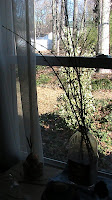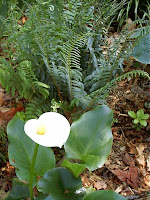
All from vintage gardening books:
A nice list of Victorian flowersand
Victorian Flower Garden Designsand
Features and Equipment of the Victorian Garden, of interest -
Garden paths or walks - how to build, How to make a Hot Bed, Fruit Gardens, Garden Manures, and Potting mixes in the Victorian era.
Popular shrubs: Azalea, Holly, Hydrangea, Rose, Lilac, Forsythia, Andromeda, Barberry, Peony, and Quince.
 Flowers:
Flowers: Delphinium, Aster, Alyssum, Chrysanthemum, Tulip, Pansy, Violet, Lavender, Daylily, Hosta, and Yarrow. Crinum lilies AKA: cemetery lilies are coming back in style.
And of course all types of ferns were popular.
I tried to find modern designs for small Victorian gardens, but they were loose interpretations, very modern(almost Zen-like) with lots of concrete patios. They should appear all natural, but somewhat controlled. They used loose and wild plantings within controlled boundaries, a bit of like a cottage garden, but more formal and tidy. The pathways were typically loose materials, not concrete or hard surfaces(unless main walkway). I'll keep looking, but
artist renditions are always a good source.
Here's one in London:

Found a good one thanks to
Homeliving: Explore the Victorian Garden: find resources, history and information about gardening in the 19th century.Other resources:
Old Fashioned Living: The Garden Path, a long list of plant and garden information.
Here's one under

construction in Britain - notice the sharp contained boundaries which will house plants that overflow giving the illusion of naturalized planting areas.
"There is a distinct atmosphere connected with those simple one-path gardens that is most delightful. It lies not only in the gravel paths and the stiff, box-borders, but in the fragrant old-fashioned flowers that were grown promiscuously inside the trim line of box."(
Garden Ornaments, 1916) This sums up Victorian gardens to a tee, and I think I feel most comfortable with this sort of garden - ordered chaos.













 I found this over at Google books, The Garden Magazine. There are many editions from 1905 - 1920's. See this main page at bottom right to view other editions. These books are downloadable and in public domain. A tip for printing or saving pages, select HMTL mode on side bar at link.
I found this over at Google books, The Garden Magazine. There are many editions from 1905 - 1920's. See this main page at bottom right to view other editions. These books are downloadable and in public domain. A tip for printing or saving pages, select HMTL mode on side bar at link.
 All from vintage gardening books:
All from vintage gardening books:

 construction in Britain - notice the sharp contained boundaries which will house plants that overflow giving the illusion of naturalized planting areas.
construction in Britain - notice the sharp contained boundaries which will house plants that overflow giving the illusion of naturalized planting areas.

 .
.